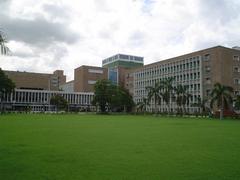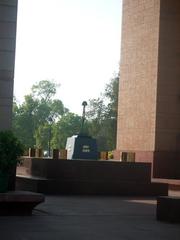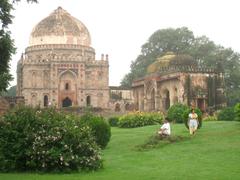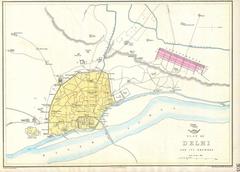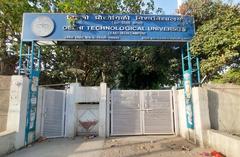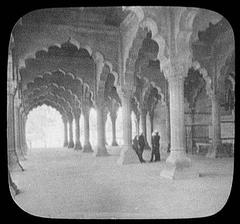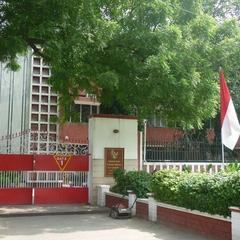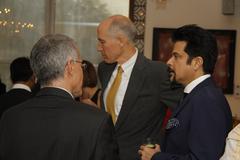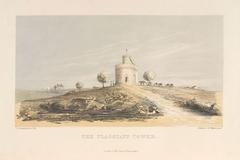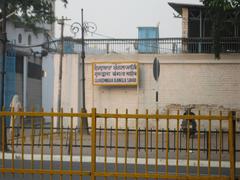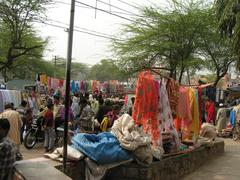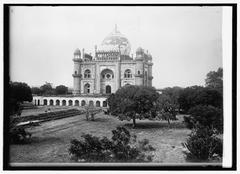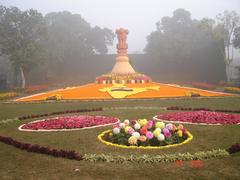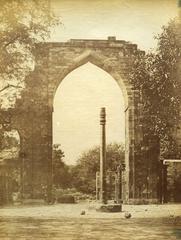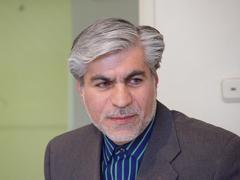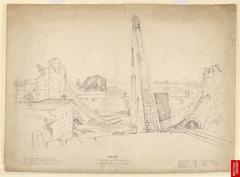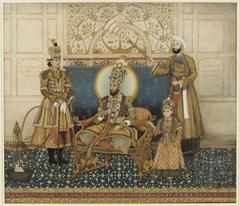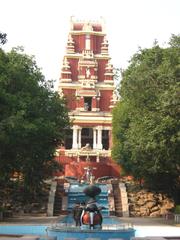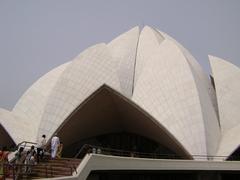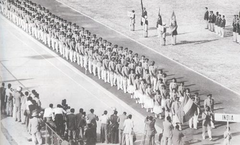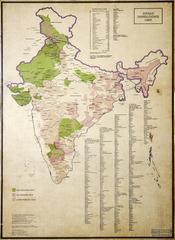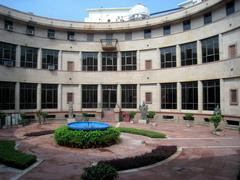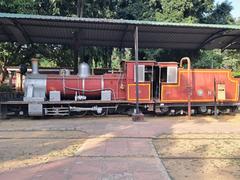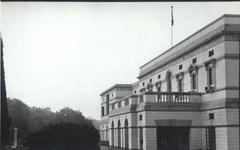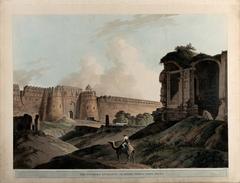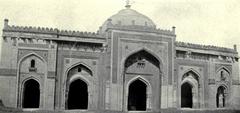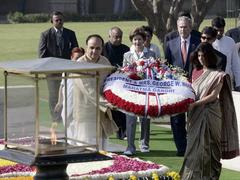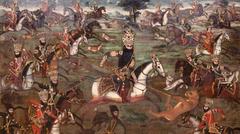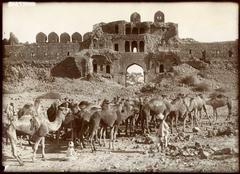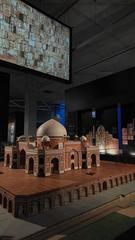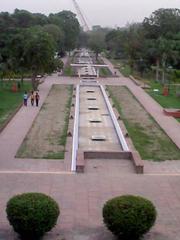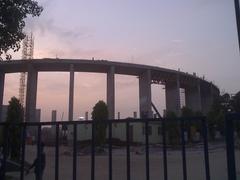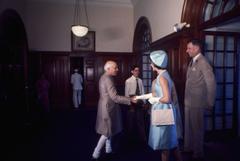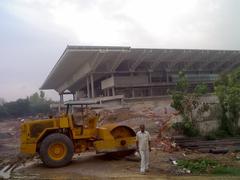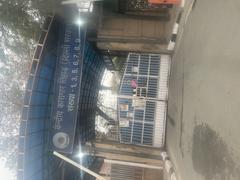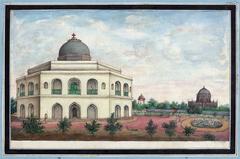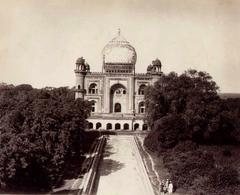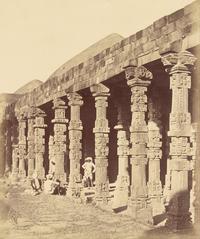National Gandhi Museum Visiting Hours, Tickets, and Historical Significance in New Delhi
Date: 14/06/2025
Introduction
The National Gandhi Museum in New Delhi stands as a profound tribute to Mohandas Karamchand Gandhi, globally revered as the Father of the Nation and a symbol of peace and non-violence. Situated at Raj Ghat, adjacent to the site of Gandhi’s cremation, the museum provides an immersive journey through his life, ideals, and the Indian independence movement. Established soon after Gandhi’s assassination in 1948 and relocated to its current premises in 1961, the museum houses an extraordinary collection of personal artifacts, rare photographs, manuscripts, and archival materials. Through its thoughtfully curated exhibits and educational initiatives, the museum not only preserves Gandhi’s legacy but also connects past struggles with contemporary aspirations for justice and peace. Whether you are a student, researcher, or a traveler seeking insight into India’s heritage, the National Gandhi Museum is an essential stop among New Delhi historical sites (mytrip.guide, Tour My India, Gandhi Museum Official).
Historical Background
Origins and Development
The National Gandhi Museum was founded soon after Gandhi’s assassination in 1948 to serve as a repository for artefacts and documents related to his life. Initially located in Mumbai, the museum’s growing collection necessitated several relocations before settling permanently in New Delhi in 1961, commemorating the centenary of Gandhi’s birth. Its strategic location next to Raj Ghat enhances its significance and offers visitors a deeper connection between the museum and the memorial site (mytrip.guide).
Mission and Collections
The museum’s mission is threefold: to preserve Gandhi-related records, promote Gandhian philosophy, and conduct educational programs that further his ideals of truth (satyagraha), non-violence (ahimsa), and social welfare (sarvodaya) (slideshare.net). The collection features over 44,000 books, 7,000 photographs, and a diverse array of Gandhi’s personal effects, including his spectacles, spinning wheels (charkhas), walking stick, letters, manuscripts, and the blood-stained dhoti and shawl he wore during his assassination (economictimes.indiatimes.com).
Educational and Social Impact
Beyond preservation, the museum actively engages the public through exhibitions, workshops, lectures, and film screenings, ensuring Gandhi’s message remains relevant for successive generations and broader civil rights movements (urbanadventures.com). Its tranquil ambiance fosters reflection on peace, non-violence, and social justice.
Architectural Setting
Location and Urban Context
Located on Rajghat Road, the museum is part of Delhi’s cultural heartland, alongside landmarks such as the National Gallery of Modern Art and Purana Qila. Its central position and proximity to other key New Delhi historical sites make it easily accessible for all visitors (mytrip.guide).
Design and Layout
The museum’s architecture reflects Gandhi’s values of simplicity and austerity. The low-rise, rectangular building is surrounded by landscaped gardens, creating a peaceful environment conducive to contemplation (slideshare.net). Inside, the museum is organized into seven primary exhibition galleries:
- Entrance Gallery: Displays Gandhi’s talisman, his famous quotations, and interactive hand telephones to listen to his speeches.
- Spinning Wheel Gallery: Showcases 23 models of charkhas, symbolizing self-reliance.
- Photographic Gallery: Features over 280 photographs chronicling Gandhi’s life and the freedom movement.
- Commemorative Gallery: Houses personal belongings, including his clothes and a letter from Rabindranath Tagore.
- Martyrdom Gallery: Contains the bloodstained shawl and dhoti worn by Gandhi at the time of his assassination, the bullet, and urns with his ashes.
- Art Gallery: Exhibits paintings, sculptures, and creative works inspired by Gandhi’s life.
- Ashram Gallery: Presents models of Gandhi’s cottages from Phoenix, Sevagram, and Sabarmati Ashrams.
The museum is fully wheelchair accessible, with ramps and wide corridors.
Integration with Surroundings
The museum’s lush gardens and pathways connect seamlessly with Raj Ghat, offering tranquil spaces for rest and reflection and underscoring its dual role as a learning center and pilgrimage site.
Visitor Information
Location and Directions
- Address: Raj Ghat, New Delhi – 110002
- Nearest Metro: ITO (Violet Line), 1.5 km away. Visitors can walk or take an auto-rickshaw to the museum entrance.
- Parking: Free parking is available, a significant advantage in central Delhi (Gandhi Museum Official).
Visiting Hours
- Open: Tuesday to Sunday, 10:00 AM to 5:00 PM (last entry at 4:30 PM)
- Closed: Mondays
- Note: Open on all public holidays
Tickets and Entry
- Admission: Free for all visitors; no tickets required
- Guided Tours: Available for groups by prior arrangement; not offered regularly for individuals
Accessibility
The museum is designed to be inclusive, with ramps, accessible restrooms, and multilingual signage. Staff assistance is available for visitors with special needs.
Visitor Amenities
- Library: Extensive collection of books and documents on Gandhi and India’s independence
- Restrooms and Drinking Water: Clean facilities on-site
- Souvenir Shop: Books, memorabilia, and handicrafts inspired by Gandhi
- Seating Areas: Benches and shaded spots for rest
Exhibits and Visitor Engagement
- Artifacts: Gandhi’s spinning wheel, slippers, glasses, walking stick, and more
- Audio-Visual Section: 137 films about Gandhi and other leaders, screened on weekends from 4:00 to 5:00 PM
- Interactive Displays: Hand telephones and touchscreens for deeper engagement
- Special Exhibitions: Temporary displays and events around Gandhi Jayanti (October 2) and Martyrdom Day (January 30)
Tips for Visitors
- Dress modestly as a sign of respect
- Photography is permitted in most areas (no flash or tripods)
- Silence is encouraged in the Martyrdom Gallery
- Weekday mornings are less crowded; October to March is the best season to visit
Safety and Security
The museum employs bag checks and CCTV surveillance. Large bags and prohibited items should be avoided.
Nearby Attractions
Visitors can enrich their experience by exploring nearby Delhi historical sites:
- Raj Ghat: Gandhi’s cremation site, surrounded by tranquil gardens
- National Museum: India’s premier history museum
- India Gate: Iconic war memorial
- Red Fort: UNESCO World Heritage Site
- Other Museums: Delhi Crafts Museum, Archaeological Museum, Indira Gandhi Memorial Museum
For more on Delhi’s heritage, see our guides to Top Monuments in Delhi and Delhi Travel Guide.
Frequently Asked Questions (FAQs)
Q: What are the National Gandhi Museum visiting hours?
A: Tuesday to Sunday, 10:00 AM to 5:00 PM; closed on Mondays.
Q: Is admission free?
A: Yes, entry is free for all visitors.
Q: Is the museum wheelchair accessible?
A: Yes, the museum is fully accessible with ramps and accessible restrooms.
Q: Are guided tours available?
A: Regular tours are not offered for individuals, but group tours can be arranged by prior request.
Q: Can I take photographs inside?
A: Photography is permitted in most areas without flash or tripods.
Q: What is the best time to visit?
A: October to March for cooler weather; mornings are quieter.
Visuals and Media
- Recommended Visuals: Images of the museum exterior, Spinning Wheel Gallery, and Martyrdom Gallery with descriptive alt tags such as “National Gandhi Museum exhibits spinning wheel”.
- Virtual Resources: Explore a virtual tour and image gallery via the official museum website.
Conclusion
The National Gandhi Museum stands out as a vital destination for those keen to explore India’s freedom struggle and the enduring message of Mahatma Gandhi. With its comprehensive exhibits, free admission, accessible design, and central location, the museum offers a unique opportunity for reflection and learning. Enhance your visit by planning ahead, exploring nearby cultural landmarks, and utilizing resources such as the Audiala app for guided tours and updates.
For the latest information on visiting hours, special events, and educational resources, consult the official museum website or trusted travel sources.
Summary and Visitor Recommendations
The National Gandhi Museum in New Delhi is indispensable for understanding Gandhi’s legacy and India’s independence movement. Its extensive collections, interactive exhibits, and commitment to public education make it both a cultural hub and an inspiration for visitors of all backgrounds. Take advantage of free admission, inclusive facilities, and its proximity to Delhi’s most significant historical sites. For up-to-date visitor info and resources, visit the official National Gandhi Museum website and download the Audiala app for audio guides and cultural updates (Tour My India, mytrip.guide, Gandhi Museum Official).
References and Further Reading
- National Gandhi Museum New Delhi: Visiting Hours, Tickets & Historical Insights, 2025, mytrip.guide (mytrip.guide)
- National Gandhi Museum Visiting Hours, Tickets & Visitor Guide in New Delhi, So City / TripInvites (so.city)
- National Gandhi Museum in New Delhi: Visiting Hours, Tickets, Collections & Visitor Guide, IJCRT / Official Museum Website (gandhimuseum.org)
- National Gandhi Museum Visiting Hours, Tickets, and Guide to Delhi Historical Sites, Tour My India / Gandhi Museum Official (Tour My India)

